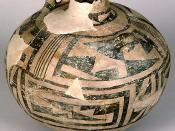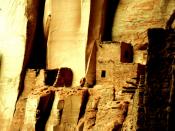Where did they go, and why did they leave? These are two of the many questions that boggle the minds of archaeologists, researchers, tourists, and many others concerning one of the largest mysteries still existing today. The Anasazi, a culture now extinct for reasons unknown. We take a journey through the past, to the four corners of our country: Colorado, Utah, Arizona, and New Mexico, the desert of the southwest. A series of long, snaking canyons cut hundreds of feet into the ancient sandstone. Extraterrestrial landscape of towering cliffs and sculpted stone winds through these deserted plateaus. Here, a thousand years ago, among these looming formations of rock and along the intermittent stream beds, the Anasazi (Navaho for "ancient ones") lived.
In the dry heat of the desert canyons, evidence of their civilization is all around. Their stone and mortar buildings, granaries, and ceremonial kivas sit abandoned, largely untouched and decayed.
Pottery, arrowheads, grinding stones, and many other century old artifacts lie in the stillness as if the inhabitants of these walls had picked up and left only weeks ago. Petroglyphs and rock art, drawn a millennium before and sheltered beneath rock overhangs, give mute expression to a culture once rich in symbolism and spirituality.
The archaeological record shows little evidence of disease or war, so what caused these people to abandon the place where they had lived and built a civilization over centuries? A number of alternatives are possible: death, migration, or aggregation into larger sites. Cannibalism and climatic change give way to the most common explanations developed as well as witch craft and the raiding of their pueblos by Toltecs.
A few pictographs, some slab-lined storage cists, plus some ambiguous evidence turned up in an archaeological excavation of a cliff shelter suggest that a small community of Pre-Puebloan...


